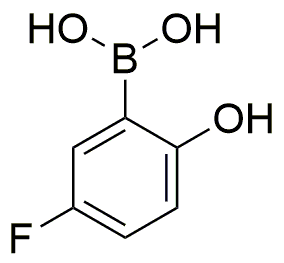5-Fluoro-2-hydroxyphenylboronic acid is widely utilized in research focused on:
- Pharmaceutical Development: This compound plays a crucial role in the synthesis of various pharmaceuticals, particularly in developing drugs targeting cancer and other diseases. Its ability to form stable complexes with biomolecules enhances drug efficacy.
- Bioconjugation: It is used in bioconjugation processes, allowing researchers to attach biomolecules to surfaces or other compounds. This is particularly beneficial in creating targeted drug delivery systems.
- Organic Synthesis: The compound serves as a versatile building block in organic synthesis, facilitating the creation of complex organic molecules. This application is vital in the production of agrochemicals and specialty chemicals.
- Analytical Chemistry: In analytical applications, it is employed as a reagent for detecting and quantifying phenolic compounds in various samples, which is essential in environmental monitoring and food safety testing.
- Material Science: The compound is also explored in material science for developing new materials with specific properties, such as enhanced conductivity or improved mechanical strength, which can be applied in electronics and nanotechnology.
General Information
Properties
Safety and Regulations
Applications
5-Fluoro-2-hydroxyphenylboronic acid is widely utilized in research focused on:
- Pharmaceutical Development: This compound plays a crucial role in the synthesis of various pharmaceuticals, particularly in developing drugs targeting cancer and other diseases. Its ability to form stable complexes with biomolecules enhances drug efficacy.
- Bioconjugation: It is used in bioconjugation processes, allowing researchers to attach biomolecules to surfaces or other compounds. This is particularly beneficial in creating targeted drug delivery systems.
- Organic Synthesis: The compound serves as a versatile building block in organic synthesis, facilitating the creation of complex organic molecules. This application is vital in the production of agrochemicals and specialty chemicals.
- Analytical Chemistry: In analytical applications, it is employed as a reagent for detecting and quantifying phenolic compounds in various samples, which is essential in environmental monitoring and food safety testing.
- Material Science: The compound is also explored in material science for developing new materials with specific properties, such as enhanced conductivity or improved mechanical strength, which can be applied in electronics and nanotechnology.
Documents
Safety Data Sheets (SDS)
The SDS provides comprehensive safety information on handling, storage, and disposal of the product.
Product Specification (PS)
The PS provides a comprehensive breakdown of the product’s properties, including chemical composition, physical state, purity, and storage requirements. It also details acceptable quality ranges and the product's intended applications.
Certificates of Analysis (COA)
Search for Certificates of Analysis (COA) by entering the products Lot Number. Lot and Batch Numbers can be found on a product’s label following the words ‘Lot’ or ‘Batch’.
*Catalog Number
*Lot Number
Certificates Of Origin (COO)
This COO confirms the country where the product was manufactured, and also details the materials and components used in it and whether it is derived from natural, synthetic, or other specific sources. This certificate may be required for customs, trade, and regulatory compliance.
*Catalog Number
*Lot Number
Safety Data Sheets (SDS)
The SDS provides comprehensive safety information on handling, storage, and disposal of the product.
DownloadProduct Specification (PS)
The PS provides a comprehensive breakdown of the product’s properties, including chemical composition, physical state, purity, and storage requirements. It also details acceptable quality ranges and the product's intended applications.
DownloadCertificates of Analysis (COA)
Search for Certificates of Analysis (COA) by entering the products Lot Number. Lot and Batch Numbers can be found on a product’s label following the words ‘Lot’ or ‘Batch’.
*Catalog Number
*Lot Number
Certificates Of Origin (COO)
This COO confirms the country where the product was manufactured, and also details the materials and components used in it and whether it is derived from natural, synthetic, or other specific sources. This certificate may be required for customs, trade, and regulatory compliance.


